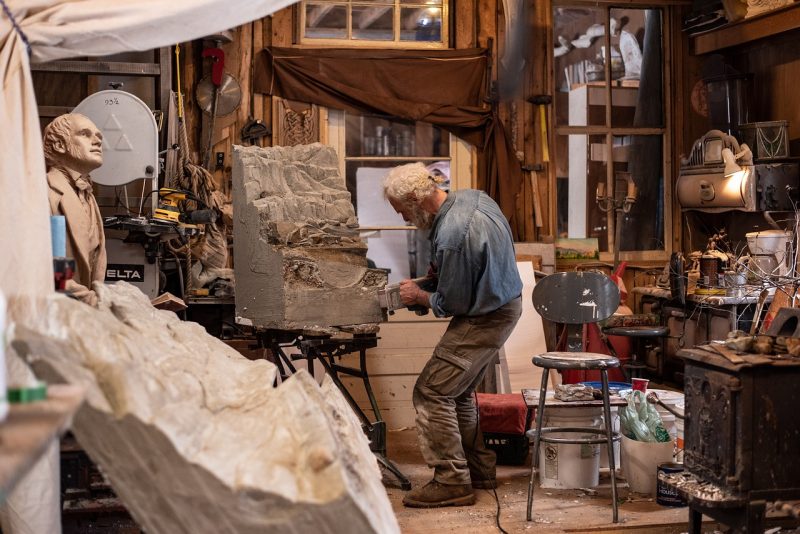
The intersections between science and art create fascinating results, from stories-tall skyscrapers to clothes made from mushrooms. The relationship is no different for the technical field of quantum science, as artists have used this topic to create some of the most bizarre and brilliant sculpture pieces. These pieces capture the viewers’ attention and encourage us to ask some of the biggest questions in science, including our existence.
Unleashing the Power of Quantum Simulations:
One of the most compelling ways quantum computing features in art and sculpture is by simulating complex physical phenomena. Artists can leverage quantum simulations to model intricate systems at a molecular and atomic scale, facilitating the creation of sculptures embodying these systems’ essence. Whether replicating the chaotic beauty of a turbulent fluid flow or the intricate dance of particles at the quantum level, quantum simulations provide artists unprecedented detail and accuracy.
One such sculptor is Julian Voss-Andreae, who uses computer programming and 3D scanning to simulate different movements or concepts within quantum physics. From showing the movement of quantum systems to buckyball sculptures, Voss-Andreae helps to bring the microscopic world of quantum physics to life. His sculptures are displayed all across the world.
Interactive Quantum Art:
Quantum computing also enables interactive art experiences that respond to the viewer’s real-time input. Quantum algorithms can quickly process vast amounts of data, allowing artists to create immersive, responsive installations. Sculptures equipped with sensors can adapt and evolve in response to the viewer’s actions, blurring the line between observer and creator. This interactive aspect enhances the viewer’s engagement with the artwork, creating a dynamic and memorable experience.
One such sculpture is “Quantum Jungle,” created by artist Robin Baumgarten, and coding provided by physics professors from various universities, including Aarhus University and Copenhagen University. Using interactive LED panels to present different quantum phenomena, from superposition to a visualization of Schrödinger’s equation, “Quantum Jungle” gives students a vivid picture of what happens at the quantum level, helping to make this science more accessible. The sculpture first debuted in 2021 and 2023 premiered at SXSW in Texas, evoking discussions about the importance of quantum science.
Exploring Quantum-Inspired Aesthetics in Sculpture:
Quantum physics has long fascinated artists, serving as a wellspring of inspiration for exploring abstract and surreal realms. Quantum-inspired art often delves into the strange and paradoxical nature of quantum mechanics, where particles exist in multiple states simultaneously. Sculptors may depict quantum superposition in their works, creating sculptures that simultaneously appear in multiple states or positions, challenging our perception of reality.
Voss-Andreae illustrates this idea beautifully in his sculpture: “Quantum Man.” Using thin metal lines to create the outline of a walking figure, Voss-Andreae challenges the viewer to approach this sculpture from multiple angles. Because of their design, the thin metal strips seem to disappear into thin air, suggesting the collapse of a quantum superposition state.
It’s no surprise that quantum computing’s impact on art and sculpture is profound and multifaceted. It enables artists to explore the uncharted territories of quantum physics, inject randomness and unpredictability into their work, and create interactive and immersive experiences. Quantum-inspired art and sculpture challenge our understanding of reality while pushing the boundaries of creativity and technology. As quantum computing advances, it promises even more innovative and mesmerizing possibilities for the world of art and sculpture, inviting us to explore the quantum universe through the lens of human creativity.
Kenna Hughes-Castleberry is a staff writer at Inside Quantum Technology and the Science Communicator at JILA (a partnership between the University of Colorado Boulder and NIST). Her writing beats include deep tech, quantum computing, and AI. Her work has been featured in Scientific American, New Scientist, Discover Magazine, Ars Technica, and more.
- SEO Powered Content & PR Distribution. Get Amplified Today.
- PlatoData.Network Vertical Generative Ai. Empower Yourself. Access Here.
- PlatoAiStream. Web3 Intelligence. Knowledge Amplified. Access Here.
- PlatoESG. Carbon, CleanTech, Energy, Environment, Solar, Waste Management. Access Here.
- PlatoHealth. Biotech and Clinical Trials Intelligence. Access Here.
- Source: https://www.insidequantumtechnology.com/news-archive/inside-quantum-technologys-inside-scoop-quantum-and-sculpture/



